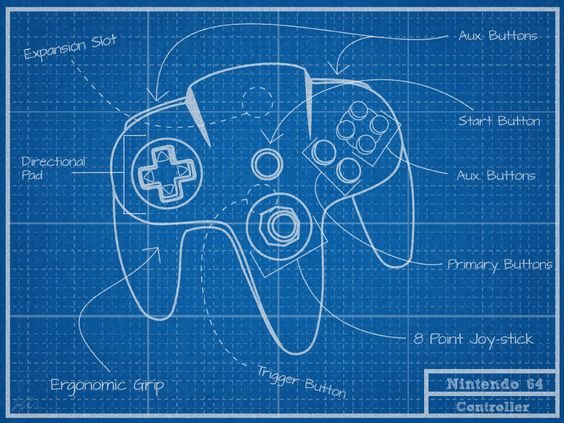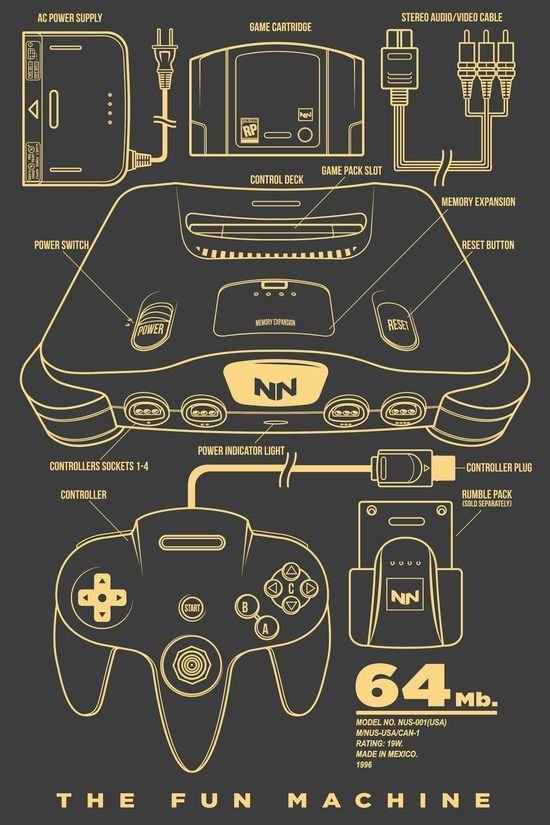Nintendo’s Revolutionary Controller
The Nintendo 64 controller is widely considered to be one of the most innovative gaming controllers ever created, and for good reason: Nintendo was the first major gaming company to meaningfully address hardware inadequacies as 3D gaming emerged alongside 2D.
Up until 64-bit gaming, controllers followed a pretty predictable tack. Super Nintendo introduced shoulder buttons. Sega Genesis added to the number of buttons on the face of the controller. Atari added a full 12 button suite to the already numerous play buttons of its notorious Jaguar. So there were variations on a theme, and that theme was by and large to add more buttons to a brick-like layout, and not fundamentally change the positioning of the hands.
The Coming War
In the mid-90s, as the console wars were really heating up, Nintendo had the popularity and the funds to explore controller alternatives, and with the advent of 64-bit processing they dove in head first. From the 3 prong design, to the inclusion of the C-Buttons, and more, the Nintendo 64 controller was a significant evolution in a design concept that had been relatively static for the 20-ish years between Nintendo establishing itself as the leader of the gaming industry and the launch of the N64.
Fittingly, it was also a gamble. As a pioneer, Nintendo was necessarily going to encounter problems they couldn’t foresee, and to miss opportunities they couldn’t predict. That’s just the name of the game; but without their brave foray into a whole new world of manipulation, its not at all difficult to imagine that gaming wouldn’t be the same today.
Innovation is often a complex pursuit, and so was the N64 controller. But for the sake of brevity, let’s say that Nintendo focused on 3 areas: buttons, form factor, and environmental manipulation.
A Novel Solution
The N64 controller has - without counting the dpad - a whopping 5 button regions to consider.
AB
Start
Shoulders
Z
C
The AB buttons bear little explanation. Over the course of gaming’s lifespan, these have been the go-to action buttons across consoles, though they may go by different names. With the 16-bit era came a promulgation of action buttons, which was considerate, but at the end of the day there’s only so many character actions to be executed with so many buttons.
Nintendo seems to have realized this, with many articles online stating that they went so far as to research button traffic and conclude that they could get away with 2 action buttons.
The Start button also bears little explanation. It brings up a standard settings HUD from which a player can adjust various aspects of gameplay. Sega notably experimented with removing the vestigial select button by merging functionality with the start button on Genesis, so we wouldn’t count the lack of a select button in the N64 controller as conspicuous, but it might be said that Nintendo wasn’t the frontrunner on that specific development.
Now, shoulder buttons were introduced in the 16-bit era, and were a bit odd at first, but eventually found their function as support buttons. Shifting camera angles, tilting a board, toggling a use-specific HUD, they were quite important in expanding the horizons of what a player could modify both of the character they were playing as and the world that that character existed in. In a very real sense, shoulder buttons expanded the universe of what is possible in-game.
We’re Not in Kansas Anymore
But this is where things stop being so simple, and requires a brief sojourn into the world of experimental form factor addressing the new needs of 3 dimensions in gaming.
The dpad, a well-loved and time worn staple of gaming, bumped up against its limits with the introduction of 360 degrees of rotation; An analogue stick makes far more sense for controlling a character in an open world. As such, the realization of the need for and the inclusion of said analogue stick is at the core of the N64 controller, the genius of Nintendo at this time, and also the short comings it either produced or made apparent.
Cutting to the chase: Nintendo felt the need to compartmentalize control style. Was this intentional? Due to shortsightedness? An accident? Who’s to say, but what is apparent in the design of the N64 controller is that analogue and dpad were considered so different that they merited completely different layouts that ought not be married.
What’d You Say?
The core action buttons should remain relatively static in placement, but the 2 types of directional control merited separate positions, thus we get a trident shape, which leads us back to shoulder buttons and a potentially contentious statement.
The Z Button is a 3rd shoulder button, and not a “trigger.”
2 things to consider here:
When using the dpad on N64, you have easy access to the L shoulder button; when using the analogue stick and in the absence of the Z button, forcing the user to use the L shoulder button is unwieldy
“Trigger” is a word that is highly associated with guns, and Nintendo has a long history of gun flops for the NES and SNES. It doesn’t make much sense for them to introduce an element of their controller that is so strongly linked to such a specific use.
The epiphany here is that the Z button wasn’t some wholly novel button, but rather one meant to accommodate the addition of an analogue control stick that was deemed unique enough to occupy an entirely separate region of the controller than the dpad.
Mind Expansion
Now come the C buttons, which are also a result of the introduction of 3D where camera control becomes wildly more important than in 2D, but also more dynamic, as became especially obvious with the introduction of first-person shooters and their (!) 1st person perspective, what differed from, for example, Mario 64’s 3rd person camera system.
And so what we really have here is forensic, historic evidence of Nintendo’s attempts to predict where 3D would take us. It got some things right, and other things not as right, but it can’t be denied that the N64 controller’s experimentations in 3 dimensional character and environmental manipulation were paramount for the development of the 64-bit era such that produced the circumstances we now find ourselves in.
Great job, guys, would love to see more experimentation soon!


